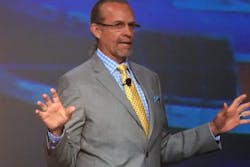NSC 2017: In NASCAR and In Life, Safety Never Takes a Holiday
For NASCAR driver Kyle Petty, safety is part of life both on and off the track, and this was apparent as he spoke to attendees at the National Safety Congress in Indianapolis.
Petty comes from a long line of accomplished NASCAR drivers and, as he explained, staying safe on the track is something that is top priority.
“Safety never takes a holiday,” he said. “You have to be on 24/7. You always have to know what’s going on.”
Trophies never meant anything to Petty’s grandfather, Lee Petty, when he began racing in 1949. For him, racing cars was about feeding his family. Back then, safety was on the back burner. In fact, Petty’s grandfather believed that seat belts were the worst thing that happened to the auto industry because “you were safer if you were thrown outside the car than remaining inside.”
Throughout the next few decades, safety innovations greatly improved safety in the racing circuit. The Petty family was involved with many of them, Petty told the audience.
One of the most notable advancements was the inner liner, or a rubber sheet within a tire. Petty’s father, NASCAR driver Richard Petty, was one of the few drivers that participated in the testing of the safety feature at Daytona.
“Racing for us was trying to make the car better for us, not only for the team, but for everyone,” Petty said. “There were so many things that came out of my dad’s shop.”
Another NASCAR safety innovation from the Petty family was created after Kyle Petty was thrown out of his vehicle while racing. After the incident, Petty’s grandmother sewed a net to be placed over the car window so that the driver would not be ejected. Today, the nylon safety net is standard and required in racing.
At some point between the 80s and 90s, NASCAR became more reactionary and not proactive about driver safety. It wasn’t until a series of driver deaths in the early 2000s that additional safety features were developed such as a redesign of racecar interiors.
“We’re still fighting issues, but we’re not fighting issues like we were before,” Petty said. “There are always new safety innovations – things you never see that help everyone that you don’t know about.”
One such safety feature, the HANS seat belt that keeps racecar drivers in place during high speed accidents, was invented after Petty’s son Adam lost his life during a practice session after hitting a wall.
“Be blessed to use what you have to help other people,” Petty concluded, “and always remember: safety never takes a holiday.”
